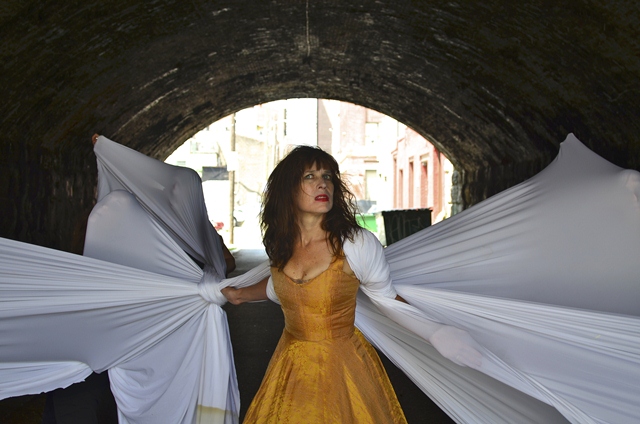The Live Arts Festival in Philadelphia provided a thought-provoking and creative piece with the Swim Pony Performing Arts production of LADY M. Historically, festival performance venues range from grand theatrical locales to basements in the midst of renovation. LADY M was given The Arts Bank building as its venue and the space provided a visceral backdrop. This uncomfortable feeling came from the elaborate, visually wispy and yet heavily used webbing design of Lisi Stoessel. Between the spider web design and the gray, murky color tones used by Maria Shaplin, an ambience of uncertainty accompanies the audience to their seats.

Catherine Slusar stars as LADY M, a Live Arts Festival offering running at the Arts Bank at the University of the Arts through September 9. (Photo credit: Mark Valenzuela)
As Macbeth is a staple for theatres everywhere, the assumption of LADY M is that everyone is familiar with the basic character of Lady Macbeth as presented by Shakespeare. Adrienne Mackey and Catharine K. Slusar have conceived and introduced a dynamic, more fully realized Lady Macbeth whose ambitions and rejections are much more palpable. Mackey, together with Lauren Feldman and the Ensemble, wrote a production pulsing with possibility and promise. Introducing Lady Macbeth as a woman awakening from sleep allowed the audience an easy connection to her. Lady Macbeth’s initial conversation with the audience is formal but contemporary as her buried thoughts and omnipresent wants are revealed. The combination used throughout LADY M of quoted lines from Shakespeare’s written Macbeth liberally combined with contemporary thoughts keeps the focus securely on the lady of this castle. Similar to Shakespeare’s Macbeth, Mackey’s conception links Lady Macbeth with her own set of guiding “spirits” represented by a slithering, acrobatic and vocal cadre of performers who provide assurance, physical support and emotional reinforcement as Lady Macbeth wrestles with who she is and what she wants to become. With obvious feminist twists, LADY M shows the up-close-and-personal struggles of a woman buried in a time with almost insurmountable behavioral and marriage constraints. LADY M allows a sharing of deep-seated emotional decisions made which help this Lady Macbeth achieve her long-awaited glory and which then lead to her feeling less-than-nothing as Macbeth’s successes and maniacal behaviors correlate with her own ultimate dissolution.
Seeking, cajoling, criticizing, ranting, reveling, despairing, and ultimately dying are highlighted emotional levels shown by Catharine K. Slusar in her performance as Lady Macbeth. Slusar’s fearless and very physical performance brought this radiant and radical Lady Macbeth to full life. The decision by Mackey to keep the ensemble entirely female and to allow Charlotte Northeast the opportunity to play Macbeth on stage was most gratifying as well. Northeast imbued Macbeth with definitively male characteristics while at the same time using feminine power to give greater depth to the uncertain side of Macbeth. Whether intended or not, the towering height of Slusar over Northeast also worked as a physical representation of this particular LADY M dichotomy.
Kudos to Jamie McKittrick and Daniel Perelstein for the movement and sound combinations for Mary Lee Bednarek, Kate Black-Regan, Amanda Damron, Karen Getz, Colleen Hughes, Kelly A. Jennings, Jamie McKittrick, Catherine Palfenier, Wendy Staton and Anna Watson. This unique, very un-Greek-like chorus worked extremely well to support the action on stage. The buzzing of bees in a hive, tonal sounds at varying volumes, and rounds of repeated snatches of conversation together with the sense of spiders moving toward prey and insane-like thrashing on the floor were used effectively to support the production.
At times the pounding sounds drowned out performances, especially Charlotte Northeast, and that is quite regrettable. The production structure begins with a linear presentation of events and does an innovative backward movement to the beginning. Ending there would have eliminated about 30 minutes of seemingly repetitive action. This concept and the strength of LADY M lies in its need to convey this Lady Macbeth with power and theatricality. Cut this a bit and this conceptual piece of theatre is ready for the big time.
LADY M
Conceived by Adrienne Mackey and Catherine K. Slusar
Additional Writing by Lauren Feldman, Adrienne Mackey and the Ensemble
Movement by Jamie McKittrick
Directed and Vocal Arrangements by Adrienne Mackey
September 3-9, 2011
Arts Bank at the University of the Arts
601 South Broad Street, Philadelphia PA
215-413-1318
www.livearts-fringe.org


